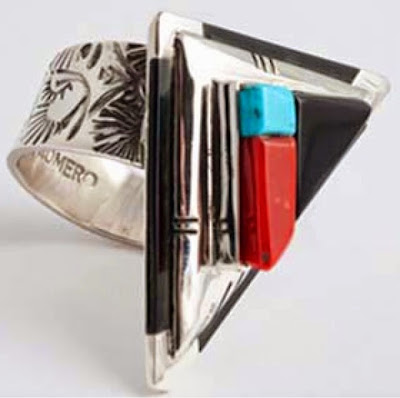This "old-style" bracelet with a 1930s era-inspired design complete with Harry Morgan's "old pawn" finish features the colorful legendary Zuni inlaid figure of Knifewing. Harry Morgan inlays are extremely rare. "Old pawn" finishes mimic the patina and appearance of naturally-aged sterling silver.
The Knifewing, or the "Achiya La-da-ba" in the Zuni language, is a Zuni war god who also protects the Zuni pueblo from harm. Zunis believe that their war gods live in lakes in New Mexico and Arizona and appear as needed. To the Zunis, the Knifewing's role is similar to that of a patron saint.
In more modern times, Zuni legends tell of Knifewings swooping down from the heavens and kidnapping attractive Zuni women.
The Zunis, believed to be the direct descendants of the mysterious Anasazis of the Four Corners area (think the Mesa Verde ruins), have lived next to their revered Zuni Mountain (about 20 miles south of Gallup, New Mexico) for hundreds, if not thousands, of years. They successfully evaded the United States Army's 19th century internment and relocation campaigns (which were, more often than not, poorly disguised genocide programs) by hiding on Zuni Mountain for several years.
The bracelet shown here boasts 40 hand-cut black jet, white shell, red Mediterranean coral, and Sleeping Beauty turquoise inlays, in eight separate inlay channels. Harry Morgan added two short lengths of delicate triangle and twisted rope wire overlays and a hand stamped sacred shell on both shanks.
This revivalist bracelet has a maximum width of nearly two inches, and its sturdy three triangle wire open bracelet frame tapers to one-half inch in width at both reinforced terminals.
Each inlaid bracelet is a unique work of art, and a comparable Harry Morgan bracelet, if available, would now carry at least a price tag of more than $2000 (if not more) in many New Mexico and Arizona galleries. This extraordinarily well-crafted, "old pawn" finish work of art is typical of the truly consummate attention to every detail that Harry Morgan was known and celebrated for. It's as "perfect" as any piece hand-made jewelry can be.
There are an extremely limited number of new, never previously-owned, Harry Morgan pieces of any kind offered in the marketplace. Before his premature death, he suffered a long illness that caused an substantial decline in his production. Even before his illness, Harry Morgan never made the choice that younger artists often make -- of compromising quality in order to achieve quantity.
If Harry Morgan's bracelets fit, and you can afford only one museum-quality piece, many collectors agree his work is the work to buy, both because of its inherent beauty and it's "investment potential."
Harry Morgan's hallmark and sterling stamp are found on the gap side surfaces of the terminal reinforcements.












































